Ballet Diary No. 2: Introduction to the “Ballet Diary” series; New York City Ballet: Wayne McGregor’s Outlier; Alexei Ratmansky’s Namouna, A Grand Divertissement / David H. Koch Theater, Lincoln Center, NYC / NYCB season: April 29 – June 27
Note: This is No. 2 in the series “Ballet Diary,” commenting on the spring seasons of New York City Ballet and American Ballet Theatre, along with related performances. To read the previous piece in the series, click here: No. 1. The completed “Ballet Diary” series will comprise nine essays.
Outlier, commissioned from the British Wayne McGregor by New York City Ballet for its “Architecture of Dance” festival and set to Thomas Adès’s Concerto for Violin–Concentric Paths, had its world premiere May 14 at Lincoln Center’s David H. Koch Theater. I can’t say that the earth moved.
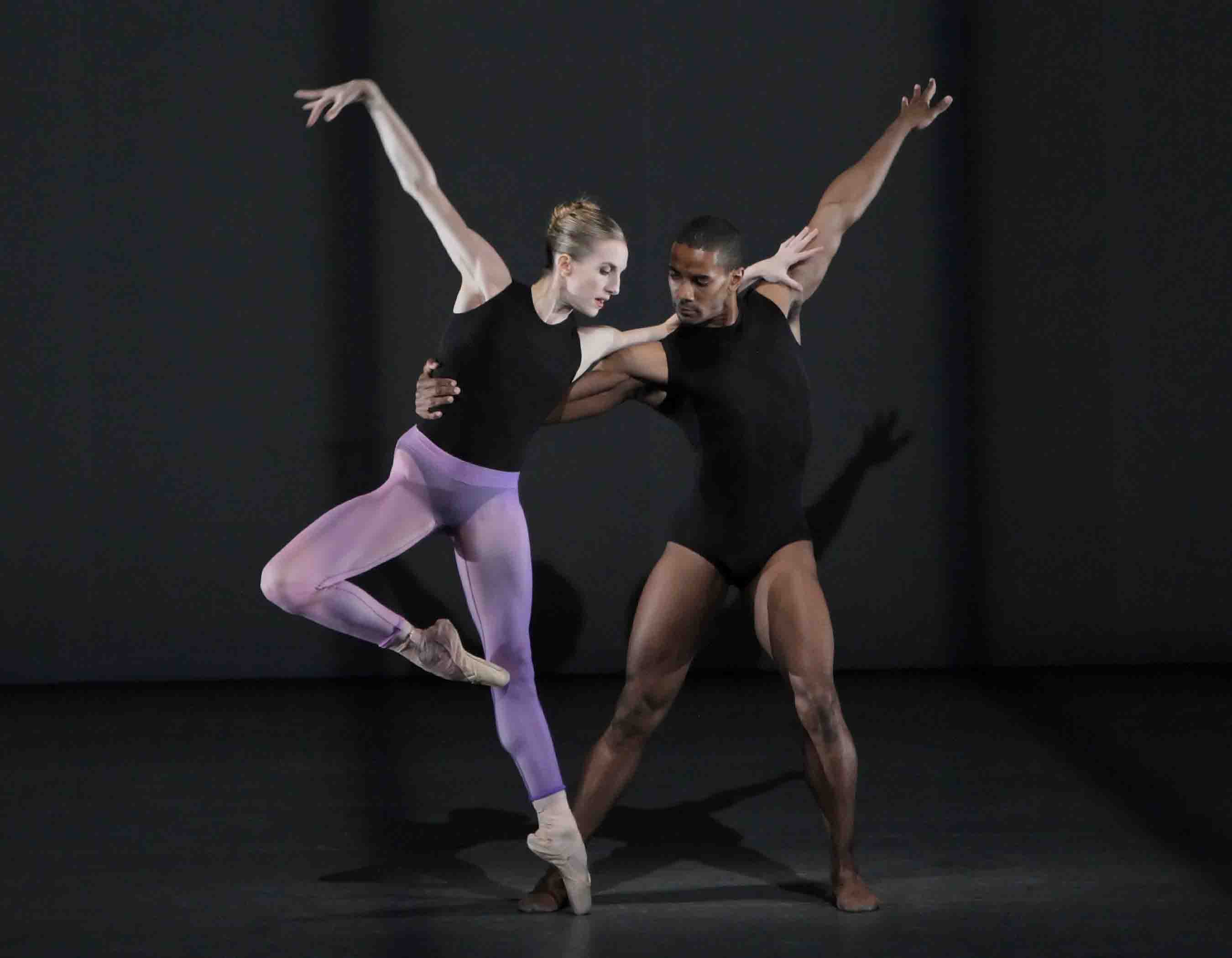
Wendy Whelan and Craig Hall in Wayne McGregor’s Outlier, one of the seven new works in New York City Ballet’s “Architecture of Dance” festival
Photo: Paul Kolnik
McGregor’s work is new to New York but his reputation has preceded him. Two years ago, though he was known as an ostensibly cutting-edge dance maker, he was appointed resident choreographer of the London-based Royal Ballet, much to the consternation of the company’s fans accustomed to a repertory dominated by traditional classical ballet.
Dance aficionados began talking about McGregor as a major player in the avant-garde when he founded his own small troupe, Wayne McGregor | Random Dance, back in 1992. (Notice the bracing vertical line instead of the conventional leaning slash. Talk about eloquence in punctuation!) Eventually the group became the resident company of Sadler’s Wells, the London half of an ambitious producing organization; New York’s City Center is its Stateside partner.
Random Dance is purportedly a poster company for “making it new.” Its repertory is often set to sound scores that are not your grandmother’s music. Its movement typically ranges from the fractured (think Jorma Elo) to seemingly boneless fluidity (I can’t help thinking of this as “the worm effect”). Frequently it reverts to a base of classical ballet technique commanded in an underpowered way by the group’s otherwise attractive dancers. The choreography revels in co-opting the ever-burgeoning paraphernalia being developed in the fields of science and communication and is naturally multi-media inclined. Of course this aesthetic influences McGregor’s work for some of the world’s topnotch exponents of classicism.
Actually, from the videotapes I’ve seen, none of McGregor’s choreography looks very new to me–not new in the sense of the early-through-middle-period Martha Graham and Twyla Tharp.
Outlier is a suave piece of work. It is neither dumb nor vulgar; this, I reckon, is a plus. The reticent backdrops (by McGregor and Lucy Carter, who also designed the lighting) and the costumes by Moritz Junge (essentially practice clothes in muted colors, set off here and there by a bare male torso or uncovered legs) almost shout “good taste.” The Adès score is a brainy post-modern affair. (An explication of it, handed out to the press, is written in a highfalutin style that would have made E.B. White chuckle.) The music itself requires a close concentration well-nigh impossible to give it while focusing on the choreography it accompanies–at least on one’s first experience of the two elements.
The choreography capitalizes on the extreme elasticity that is a by-product of a classical dancer’s training, but surely not the chief goal of that training. To my mind, the arduous, nearly decade-long process of preparing a carefully selected aspirant for a professional life in ballet aims to teach him or her to move with clarity while maintaining rhythmic phrasing, physical flow, and expressive eloquence. Pliability (an element essential to gymnasts and contortionists), is important but it doesn’t lie at the center of the art of dancing.
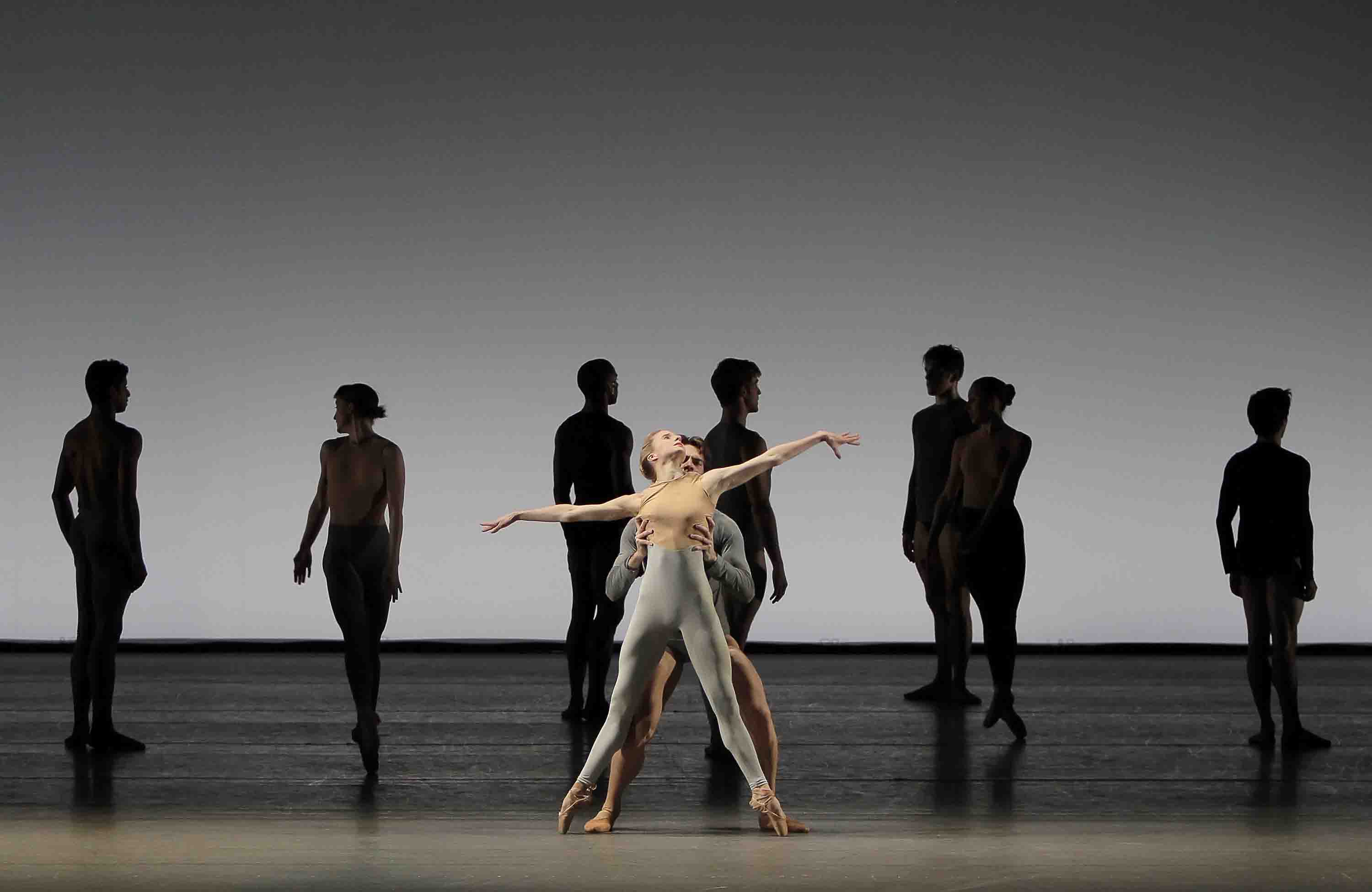
Sterling Hyltin and Gonzalo Garcia in Wayne McGregor’s Outlier, one of the seven new works in New York City Ballet’s “Architecture of Dance” festival
Photo: Paul Kolnik
The initial duet in Outlier reveals McGregor’s limitations straight off. A man prowls around a woman, then co-opts her as his partner. First he gently explores her flexibility, sculpting her body into extreme shapes and treacherous positions. He’s a Pygmalion fixated on his subject’s ball bearing joints. She doesn’t seem to have any say in the matter, even when he briefly gets a touch rough-handed with her; her role is to agree, to submit. More dismaying than this possible violation of pc behavior is the fact that there’s no physical logic to the movement sequences. One phrase glides smoothly into the next, but an ensuing move never feels like the inevitable consequence of the preceding one.
Later, a sextet makes various connections, with all of the participants appearing to be in a state of anomie, subservient to their fate. In a quartet for three men and a woman, one of the men has a push-me pull-you duet with the woman, followed immediately by a more balletically conventional one with one of his buddies. On the whole, though, the presence of academic steps in Outlier is sparse, while the vocabulary used is gravely limited.
The piece was handsomely executed by its eleven dancers, Craig Hall, Wendy Whelan, and Tiler Peck being exceptional. These three were so in control of the strange movement, they could make it look almost natural–as if it spilled directly from their guts. And still it failed to offer any meaning.
Of the four new ballets unveiled so far in New York City Ballet’s “Architecture of Dance” festival, the one to get excited about is Alexei Ratmansky’s Namouna, A Grand Divertissement. On its first showing I wrote about it briefly in Ballet Diary No. 1. Having seen it again, twice, since its premiere, I want to say more.
Born in Russia and trained in the school of Moscow’s Bolshoi Ballet, Ratmansky failed to make it into the parent company and danced with a series of geographically disparate troupes, all the while developing his gifts as a choreographer. Eventually–talk about irony!–the Bolshoi called him home to become its artistic director. No happy ending–yet. He found that the administrative work of the job left him insufficient time in which to choreograph and tendered his resignation. He then flirted with New York City Ballet (for which he’d already made a pair of well-received pieces) as a possible replacement for Christopher Wheeldon, who was giving up his position as the company’s resident choreographer to form his own group (which he has since abandoned). When the City Ballet opportunity went up in smoke, Ratmansky became–as quick as you can say “about face”–American Ballet Theatre’s artist in residence. He made certain that his arrangement with ABT allowed him to choreograph elsewhere as well–like Wheeldon, he’s in demand worldwide–and so City Ballet has his wonderful Namouna.
The music for Namouna, by the French neo-Romantic composer Édouard Lalo, was originally created for a ballet by Lucien Petipa (brother of the more celebrated Marius) that had its premiere at the Paris Opera in 1882. Neither the ballet nor its score–accused of being “too symphonic”–caught the public’s fancy, and the production disappeared from the repertory after a mere 15 performances. Confident that he had composed something of value, Lalo repurposed his music into two orchestral suites and other pieces for the concert stage. For his ballet, Ratmansky marshaled 16 of the numbers that had been recorded by David Robertson and the Orchestra of Monte Carlo on a CD of these pieces.
The music is a mélange of myriad perfumes, by turns exotic, nostalgic, dramatic, sensuous, playful, and lamenting. It is full of rhythmic vitality, grace, and charm. And, despite what the Parisian audience thought in the 1880s, the orchestration is lovely.
The original ballet for which the Namouna score was created was apparently a kind of Le Corsaire affair (possibly tinged with a musky Arabian Nights atmosphere) and boasted a plot that would be considered outlandish today. Ratmansky jettisoned the idea of narrative but continually hints at stories through the “characters” he’s created.
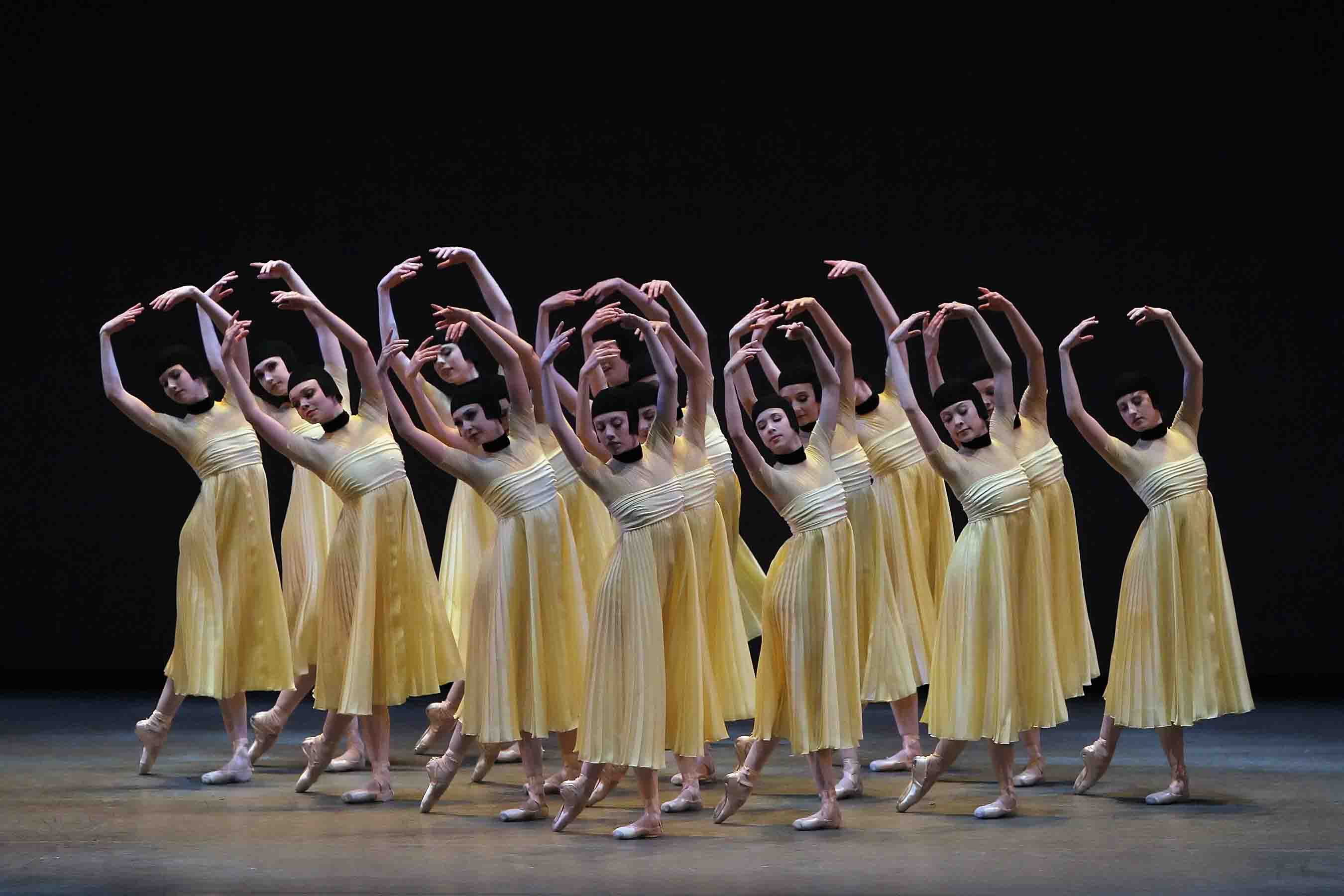
The women in yellow, from Alexei Ratmansky’s Namouna, A Grand Divertissement, one of the seven new works in New York City Ballet’s “Architecture of Dance” festival
Photo: Paul Kolnik
The ballet opens with the entrance of an ensemble of 16 seemingly identical women, dressed in gowns of chrome yellow falling below the calf. They’re capped with pitch-black wigs severely styled in the manner of Louise Brooks’s iconic bob; black chokers circle their necks. Their arms are flung backward, giving them a heroic–and faintly menacing–air. At first they step slowly and deliberately in a straight line, but then the line swirls into a circle, next into a pair concentric circles, and soon Ratmansky assigns them, one at a time, increasingly aberrant actions that define individuals within this sisterhood of clones.
Our Hero (Robert Fairchild) is a fresh-faced young man in a white sailor’s suit, who, throughout his several solos, maintains a relaxed, modest air while delivering amazing technical feats. Gradually we come to realize that he’s searching for Ms. Right, a role for which three women “audition.” They are Jenifer Ringer (in French blue), at once sweet and, dancing a long solo with a lit cigarette, sassy; Sara Mearns (in midnight blue), who recalls Suzanne Farrell in the amplitude, suppleness, and daring of her dancing; and Wendy Whelan (in the palest ice blue imaginable), who counters Mearns’s primal energy with her reticence and delicacy. Whelan wins out (though she never competes) and so gets to perform the tender closing pas de deux with Fairchild. Highlighting this duet is a sequence of remarkable lifts, in which she appears both weightless and luminous, as fragile as spun glass. The curtain falls on the pair sealing their bond with a prolonged Hollywood kiss.
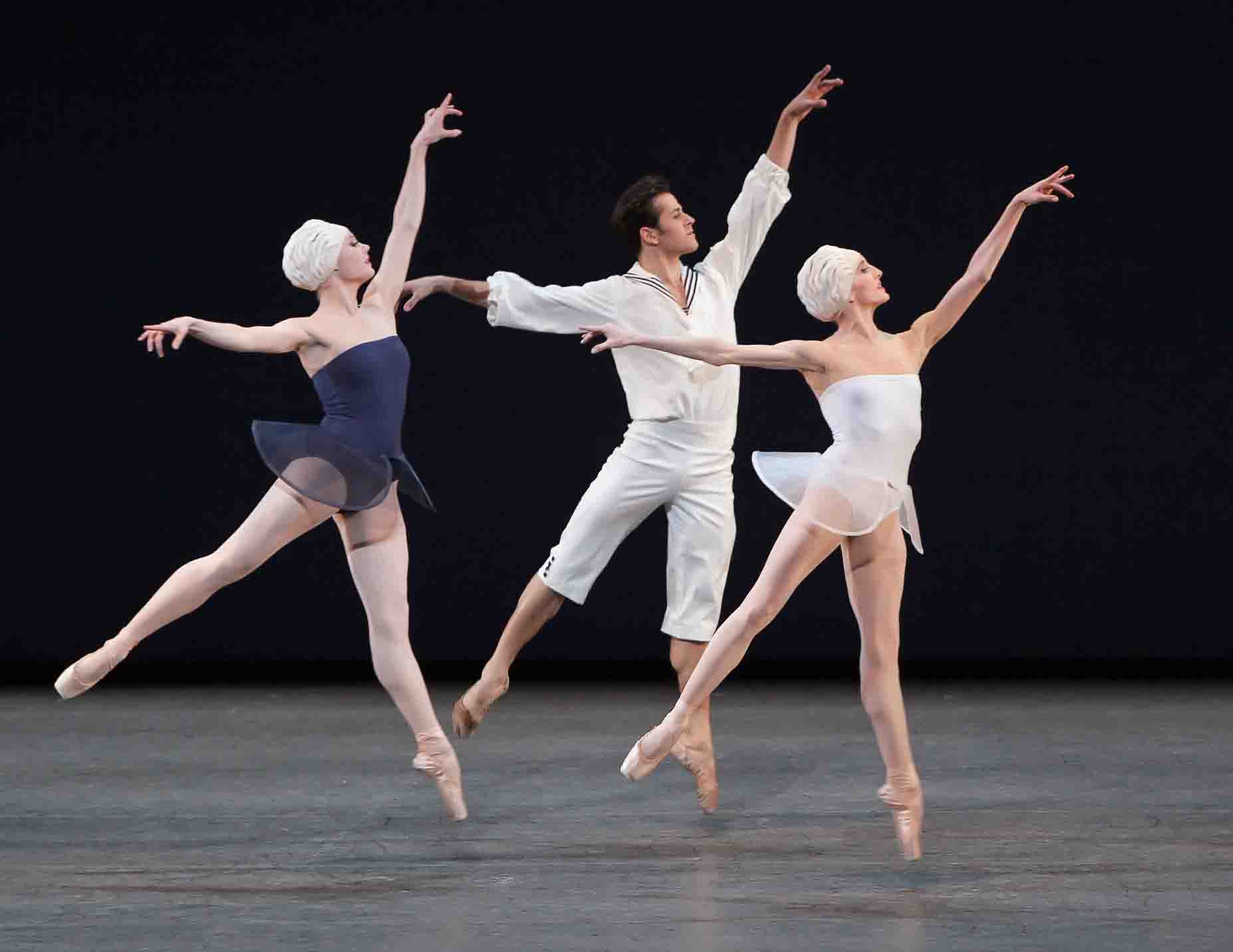
Sara Mearns, Robert Fairchild, and Wendy Whelan in Alexei Ratmansky’s Namouna, A Grand Divertissement, one of the seven new works in New York City Ballet’s “Architecture of Dance” festival
Photo: Paul Kolnik
One step lower in importance, yet indispensable to the proceedings, is a trio of diminutive dancers in bronze: Daniel Ulbricht–of the bulging muscles that allow his spectacular tours de force, yet as buoyant as a helium balloon–and a pair of piquant women, Megan Fairchild and Abi Stafford. Presumably, the job of these three is to provide variety through steps particularly suited to their body type and to show us the cunning ways in which a trio, and only a trio, can be manipulated.
At one point Ulbricht repeatedly picks up one of his playmates and shifts her position from one side of him to the other, then does the same for the second petite miss. Although he repeats this action several times, nothing really changes. (This amusing bit of business points to a significant irony: dance is like its sister arts in which, as Auden tells us, “Poetry makes nothing happen.”) Finally Ulbricht carries his erstwhile partners into the wings, one in each burly arm. It’s possible to think of all three figures as life-size wind-up toys or perhaps a set of mechanical dolls created by the ingenious Dr. Coppelius.
The women in yellow who opened the ballet and have important choral work in its course also double (with a speedy costume change) as a chorus of naiads with a complaint that chronically reduces them to tears: none of them becomes Our Hero’s chosen one; none of them stands a chance. In blue, then, the female ensemble can express human emotion. In their yellow guise, however, the women are simply enigmatic and powerful–messengers of fate, perhaps. In one of their most striking and eerie passages, they assemble as if rimming a large semi-circle, small brass cymbals in their hands. At intervals, they strike these together to produce a tiny, even-paced, metallic ringing. Now and then, they hold the glinting cymbals to their eyes and the musical instruments seem to morph into cameras or opera glasses–both tools designed to “steal” images. As always, their faces are completely devoid of expression.
Last, though hardly least, is an octet of men who might be, guessing from their costumes, members of a motorcycle gang. They are chivalrously present whenever a bunch of feisty guys is needed–rescuing a maiden from drowning, for instance, or partnering the yellow gals in a spate of deep-rooted folk dancing.
Shunning plot and specifically identified characters, Ratmansky was hardly likely to pin down the setting of his ballet, but it’s surely somewhere by the sea, that realm of fanciful dreams. At times, the action even seems to take place underwater; those women in blue might be mermaids. And the sea might well be the Mediterranean; Lalo wrote his score for a ballet set on Corfu and, some 130 years later, isles-of-Greece hints survive in Ratmansky’s choreography.
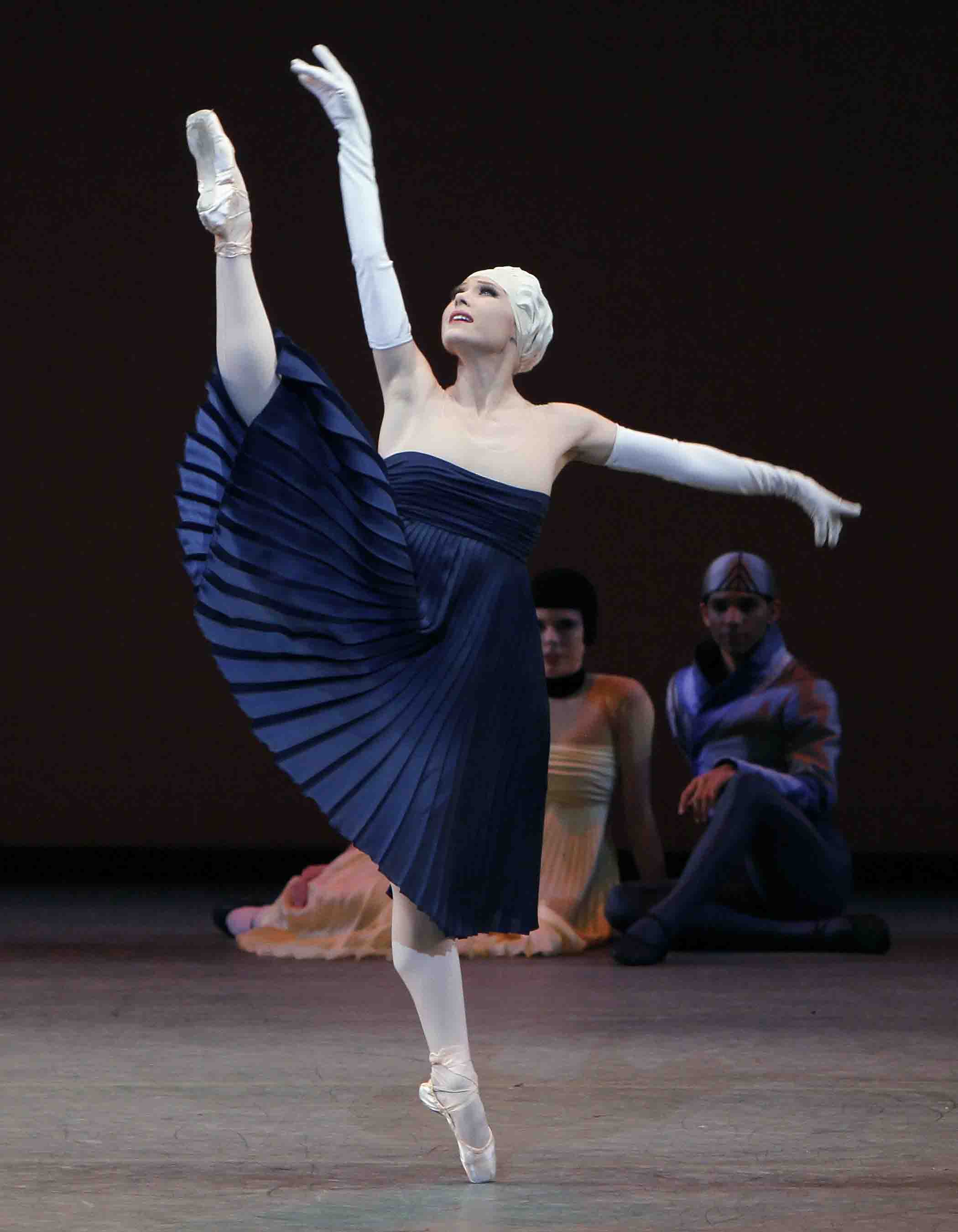
Sara Mearns in Alexei Ratmansky’s Namouna, A Grand Divertissement, one of the seven new works in New York City Ballet’s “Architecture of Dance” festival
Photo: Paul Kolnik
Almost as if in passing, Ratmansky quotes from every ballet you’ve ever loved–seen or merely heard about–and no doubt several that flew under your radar. Some of the most obvious references are to: the arabesques voyagées of the corps of wilis in Act II of Giselle (which Ratmansky assigns to the motorcycle-gang octet); the frantic gestures of Gennaro, the hero of Bournonville’s Napoli, when he thinks he has allowed his beloved to drown (which Ratmansky gives to a woman); a lexicon of Danish mime gestures, themselves borrowed from France or Russia–“beautiful,” “love,” et al.; the elegiac dance of the ensemble of swans that opens traditional versions of Swan Lake‘s Act IV, now heinously omitted from zippy new versions of the ballet because it’s thought to slow things down; bits of Balanchine plucked and tweaked from sources as diverse as Apollo, La Sonnambula, and Mozartiana; and even a few signature devices of Paul Taylor’s. Ratmansky singles out these moves, wittily shifting their context and purpose, in ways that simultaneously reveal their absurdity (for ballet is essentially both absurd and sublime) and his delight in them.
Blessedly, the scenic investiture of Namoura consists simply of a backdrop onto which Mark Stanley plays light in various colors. (A Santiago Calatrava installation–like those created for five of the season’s seven new works–would surely have been a roadblock.) Marc Happel and Rustam Khamdamov designed the costumes. In some instances these are handsome–Mearns’s long-skirted navy gown, for instance, gives a luxuriant dimension to the term “accordion-pleated.”
Elsewhere–especially when it comes to the ladies’ thick white “bathing caps,” suggesting cresting waves or perhaps a Marcel wave of the Twenties–they are over the top.
I loved Namouna from its first showing at City Ballet’s opening night gala, but it was on a second viewing that everything fell into place for me. What had seemed to be the busiest and one of the longest one-act ballets ever made was suddenly fully clear–in its beauties, its wit, and its ability to induce waves of nostalgia, even for things I had never seen firsthand.
© 2010 Tobi Tobias




I was able to see “Namouna” but once; clearly it demands repeated viewings. However, from its very opening I felt Ratmansky was telling us about his heritage as well as reminding us specifically of “Bayadere.” The intriguing entrance of the corps (Shades) as well as the oriental caliph-like headdresses suggested “Bayadere,” I thought, even though he alludes to other Romantic ballets throughout. I was also reminded of Balanchine’s statement: “There are no new steps, only new combinations.” What fabulous combinations Ratmansky has given us!
TT’s revisiting of “Namouna” after more viewings demonstrates the value of a blog in the hands of a stylistically elegant, well-informed, thoughtful critic. She has put us in the theater with her, given us an incredible amount of context, and made me at least wish to god I could see this work. And the blog of course does offer her, and any of us who ply this lucrative trade, an opportunity to change our minds, to admit that the first impression isn’t necessarily the right one (though it certainly can be).
As for the Wayne McGregor, I’ve seen his company, Random Dance, perform quite recently here in Portland. I would rather go through root canal than see anything of his again–that torture of dentistry at least has a healthy result; what he does to his dancers is bad for the body, the mind, and the soul.
My take on “Namouna” is so different that I will offer it up for discussion. Had not been to New York City Ballet in some time, was so excited to see new Ratmansky — had only read about him. Like Ms. Tobias and the Commentators below, I enjoyed very much the corps, indeed the whole silly spectacle (loved the cig dance)up until about 2/3 of the way through the ballet. Then I began to get a strong whiff of cynicism, produced I guess by the grab bag of ballet clichés that seemed to me very uninventively used. This feeling was produced in large part by the treatment of the Daniel Ulbricht figure who seemed to do nothing but jetés élancés de coté and assorted batterie, and especially by the last pas de deux with Wendy Whelan, which left me feeling actually insulted. She is too fine an instrument for this kind of treatment. It seemed to me the ballet would have been great for the Trocks back when they were doing creative stuff rather than putting their own spin on Petipa, etc. I sat stunned at the end and went to the restroom where I heard a fellow audience member comment to her friend, “Wasn’t that little guy good?” And “How nice the second one was so different from the first one.” (The “first one” was of course “Divertimento No. 15”) I could hardly believe I had just seen NYCB.
I think I must clarify my use of the word “lucrative” as a modifier for the profession TT and I share [See my Comment, below.]. The only thing that pays less than dancing, I’ve been known to say, is writing about dancing.
Dine artikler er altid velskrevne, oplysende og man får lyst til at se forestillingerne du skriver om – og selvom det ikke er muligt,
er det alligevel som om `noget af een´ har været tilstede hver gang.
[Your articles are always well written and illuminating. They make the reader want to see the performances you write about. Even if that isn’t possible, nevertheless it’s as if something of oneself has been present every time.]
Thank you so much for the wonderfully incisive review of the Ratmansky piece on Misha last week.
I was visiting NYC for a whirlwind 6 days of dance performances, family and friends. Luckily, Lourdes Lopez had procured two tickets and we went together on Saturday night for “Unrelated Solos.” The fully fleshed out and nuanced piece, performed with such specificity and range, was a complete and wonderful surprise. Thank god that in wading through middling evenings of dance, all the waiting and seeing things can end in a true experience of this caliber.
Your words, heart and expertise are much appreciated.
I remember being a 7-year-old girl dreaming to be a ballerina. Then I took ballet lessons. Ballet was so hard, so painful, that I gave up after three months. I am so amazed and speechless in front of such talent.
Very good article, thank you!
I’m French and I read through the google translator, but even so, I learned a lot. Thank you! (And sorry for my English.) 😉